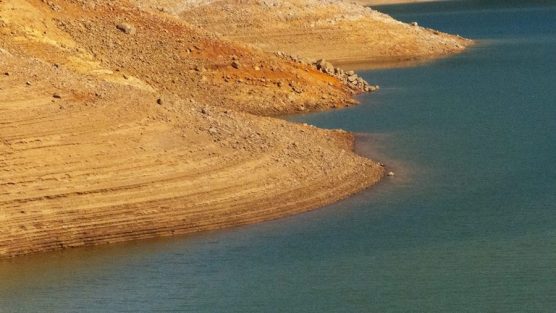SACRAMENTO, Calif. (CN) — Following two months of barren weather reports, California farmers received the most disappointing forecast yet Wednesday as the federal government warned many districts in the state’s agricultural heartland won’t get surface water deliveries in 2022.
The initial water allocation update by the U.S. Bureau of Reclamation, which manages the massive Central Valley Project, reflects the increasing severity of California’s drought, and means some Central Valley farmers could go without federally subsidized water for the second consecutive year. Reclamation officials said low spring runoff forecasts are forcing them to cautiously guard the meager amount of water currently stored behind Shasta Dam, the cornerstone of the federal water project.
The Golden State’s traditional rainy season thus far has been a back-and-forth affair, characterized by brief periods of extreme rain and snow followed by monthslong stretches of abnormally dry weather.
Parts of the state saw record amounts of rainfall thanks to a late October storm, but bone-dry conditions returned in November. A week of strong storms brought widespread drought relief in December, but much of the state has seen little to no precipitation since Jan. 1.
The lack of recent rain and snow has reservoir levels plummeting at a time when they should be filling up from runoff. According to state data, Shasta Lake sits at just 53% of its historical average for this time of the year.
Ernest Conant, bureau director of the Mid-Pacific Region, says Shasta and the upper Sacramento Valley unfortunately missed out on much of the beneficial December storms.
“We began the 2022 water year with low Central Valley Project reservoir storage and some weather whiplash, starting with a record day of Sacramento rainfall in October and snow-packed December storms to a very dry January and February, which are on pace to be the driest on record,” Conant said in a statement. “Further, the December storms disproportionately played out this year in the headwaters — heavy in the American River Basin and unfortunately light in the upper Sacramento River Basin.”
Per Wednesday’s announcement, irrigation districts south of the Sacramento-San Joaquin River Delta stand to receive no water from Shasta and the project’s associated canals. Delta contractors are slated to fare better with 25% of their historical use while the Friant Division contractors, whose water supply comes from the upper San Joaquin River, will receive a zero to 15% allocation depending on seniority.
For the fourth time in the last 10 years, Westlands Water District and other south-of-delta contractors are facing the prospect of a zero percent allocation. The nation’s largest agricultural water supplier which helps irrigate over 1,000 square miles of farmland in Fresno and Kings counties, says similar drought conditions in 2021 caused farmers to fallow over 200,000 acres.
In a statement, the district said it was “disappointed” with the initial allocation but understands the bureau must conserve water to meet state water quality and environmental standards. It added the current conditions demand a stronger response from California.
“The circumstances in 2021 and those facing us in 2022 demonstrate the need to invest in infrastructure to better manage the state’s water resources, which includes increased capacity to capture water when its available for transport and use in times of drought,” a district spokesperson said. “California needs new storage, both surface and groundwater and improved conveyance facilities.”
The Friant Water Authority reacted more bluntly, saying snowpack levels in the southern Sierra Nevada should warrant more water for growers. It warned the insufficient allocations will force Central Valley farmers to increase reliance on groundwater at a time when the state is striving to recharge depleted aquifers.
“Even if the remainder of the year is extremely dry, Friant Water Authority estimates that approximately 240,000 acre-feet of additional unallocated water supply exists in the upper San Joaquin watershed,” the authority claimed in a statement. “Not allocating water that is clearly available will only exacerbate an unnecessary rush to pump groundwater, causing additional overdraft.”
Congressman David Valadao, whose district covers a large swath of the Central Valley, called the allocations “unacceptably low.”
“This community is resilient, but the fact remains that our farms will not survive without a reliable water supply for south-of-delta agriculture,” said Valadao, R-Hanford.
Nearly three months ago California officials gave a similar preliminary allocation forecast for customers of the State Water Project. But following the December storms, the Department of Water Resources now expects to be able to deliver 15% of requested supplies.
Though there’s still a chance the federal allocations will change this spring, the bureau isn’t overly confident farmers will see much of a boost.
“We’ve got our work cut out for us this year; strengthened collaboration and coordination among agency partners, water and power users and stakeholders will be instrumental,” Conant said.
Like this:
Like Loading...
Related





 Tweet This
Tweet This Facebook
Facebook Digg This
Digg This Bookmark
Bookmark Stumble
Stumble RSS
RSS


























REAL NAMES ONLY: All posters must use their real individual or business name. This applies equally to Twitter account holders who use a nickname.
1 Comment
This is an ongoing thing. Build reservoirs in the desert, redirect water from drains(all of Los Angeles waterways were designed to move water away from cities to prevent flooding inland). Instead of spending billions on a train put it toward life saving measures and give the farmers and families what they need. Water.